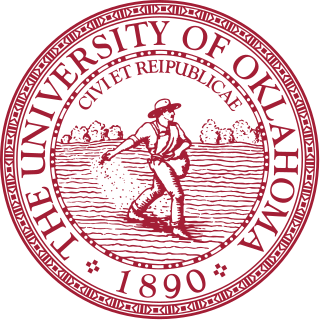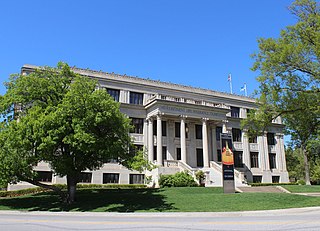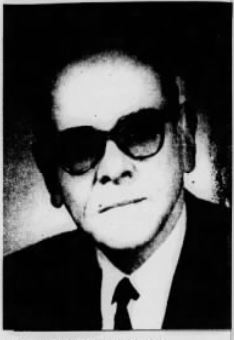
The Tulsa race massacre, also known as the Tulsa race riot or the Black Wall Street massacre, was a two-day-long white supremacist terrorist massacre that took place between May 31 and June 1, 1921, when mobs of white residents, some of whom had been appointed as deputies and armed by city government officials, attacked black residents and destroyed homes and businesses of the Greenwood District in Tulsa, Oklahoma. The event is considered one of the worst incidents of racial violence in American history. The attackers burned and destroyed more than 35 square blocks of the neighborhood—at the time, one of the wealthiest black communities in the United States, colloquially known as "Black Wall Street."

Tulsa County is located in the U.S. state of Oklahoma. As of the 2020 census, the population was 669,279, making it the second-most populous county in the state, behind only Oklahoma County. Its county seat and largest city is Tulsa, the second-largest city in the state. Founded at statehood, in 1907, it was named after the previously established city of Tulsa. Before statehood, the area was part of both the Creek Nation and the Cooweescoowee District of Cherokee Nation in Indian Territory.

Okmulgee is a city in and the county seat of Okmulgee County, Oklahoma, United States, and is part of the Tulsa Metropolitan Area. The name is from the Muskogee word okimulgee, which means "boiling waters". The site was chosen because of the nearby rivers and springs. Okmulgee is 38 miles south of Tulsa and 13 miles north of Henryetta via US-75.

Tulsa is the second-most-populous city in the state of Oklahoma, after Oklahoma City, and is the 47th-most-populous city in the United States. The population was 413,066 as of the 2020 census. It is the principal municipality of the Tulsa metropolitan area, a region with 1,034,123 residents. The city serves as the county seat of Tulsa County, the most densely populated county in Oklahoma, with urban development extending into Osage, Rogers and Wagoner counties.

Tulsa International Airport is a civil-military airport five miles (8 km) northeast of Downtown Tulsa, in Tulsa County, Oklahoma, United States. It was named Tulsa Municipal Airport when the city acquired it in 1929; it received its present name in 1963. While Tulsa International Airport only serves domestic destinations, it is still an international airport since it has customs and border patrol facilities.

The University of Oklahoma (OU) is a public research university in Norman, Oklahoma, United States. Founded in 1890, it had existed in Oklahoma Territory near Indian Territory for 17 years before the two territories became the state of Oklahoma. In Fall 2023, the university had 32,676 students enrolled, most at its main campus in Norman. Employing nearly 4,000 faculty members, the university offers 174 baccalaureate programs, 199 master's programs, 101 doctoral programs, and 88 certificate programs.
Tulsa is the second-largest city in the state of Oklahoma and 45th-most populous city in the United States.

The Tulsa Theater is a theater and convention hall located in Tulsa, Oklahoma. It was originally completed in 1914 and remodeled in 1930 and 1952. The building was used as a detention center during the 1921 Tulsa race massacre. It is listed on the National Register of Historic Places and remains in use as a theater today. The theater was previously named after W. Tate Brady but was renamed in 2019 due to Brady's affiliation with the Ku Klux Klan.

The 320 South Boston Building is a 22-story high-rise building located in downtown Tulsa, Oklahoma. It was originally constructed at the corner of Third Street and Boston Avenue as a ten-story headquarters building for the Exchange National Bank of Tulsa, Oklahoma in 1917, and expanded to its present dimensions in 1929. The addition brought the building's height to 400 feet (122 m), making it the tallest building in Oklahoma. It lost this distinction in 1931, but remained the tallest building in Tulsa until Fourth National Bank was completed in 1967. It is now included in the Oil Capital Historic District.

The Tulsa Fire Alarm Building is a historic Art Deco building at 1010 East Eighth Street in Tulsa, Oklahoma. It was built in 1931 and served as the central reporting station for the Tulsa Fire Department. Fires were reported from alarm boxes spread around town to this building and the firemen in this building would alert the fire station closest to the fire. At the time of its construction, this system was the best available alarm system. The building is just east of the Inner Dispersal Loop in Tulsa's Pearl District.

The Tulsa Performing Arts Center, or Tulsa PAC, is a performing arts venue in the city of Tulsa, Oklahoma. It houses four main theatres, a studio space, an art gallery and a sizeable reception hall. Its largest theater is the 2,365-seat Chapman Music Hall. The Center regularly hosts events by 14 local performance groups. Tulsa Ballet, Tulsa Opera, Tulsa Symphony, and Celebrity Attractions are among the Tulsa PAC's major clients. Tulsa Town Hall, Chamber Music Tulsa, Theatre Tulsa, American Theatre Company, Theatre Pops, Playhouse Tulsa, Theatre North, and the PAC Trust also fill the PAC calendar.
Downtown Tulsa is an area of approximately 1.4 square miles (3.6 km2) surrounded by an inner-dispersal loop created by Interstate 244, US 64 and US 75. The area serves as Tulsa's financial and business district; it is the focus of a large initiative to draw tourism, which includes plans to capitalize on the area's historic architecture. Much of Tulsa's convention space is located in downtown, such as the Tulsa Performing Arts Center and the Tulsa Convention Center, as well as the BOK Center. Prominent downtown sub-districts include the Blue Dome District, the Tulsa Arts District, and the Greenwood Historical District, which includes the site of ONEOK Field, a baseball stadium for the Tulsa Drillers opened in 2010.
Robert James LaFortune was an American philanthropist and politician from the U.S. state of Oklahoma. LaFortune was mayor of Tulsa, Oklahoma from 1970 to 1978.

The Civic Center Music Hall is a performing arts center located in Oklahoma City, Oklahoma. It was constructed in 1937 as Municipal Auditorium and renamed in 1966. The facility includes the Thelma Gaylord Performing Arts Theatre, the Freede Little Theatre, CitySpace, the Meinders Hall of Mirrors and the Joel Levine Rehearsal Hall.

Central High School is the oldest high school in Tulsa, Oklahoma. It was founded in 1906 as Tulsa High School, and located in downtown Tulsa until 1976. The school now has a 47-acre (19 ha) campus in northwest Tulsa. Tulsa Central is part of the Tulsa Public Schools, Oklahoma's largest school district, and is a public school for students from grades 9 through 12. Since 1997 it has served as a fine and performing arts magnet school.

The Tulsa Union Depot is the former central railway station for Tulsa, Oklahoma. It has since been turned into an office building. The Oklahoma Jazz Hall of Fame is currently headquartered in the former Depot.
The following is a timeline of the history of the city of Tulsa, Oklahoma, United States.

The Mid-Continent Life Building is a historic building at 1400 Classen Drive in Heritage Hills, Oklahoma City, Oklahoma. It was built by Col. R.T. Stuart, who was the founder of the Mid-Continent Life Insurance Co to house his company and was designed by Solomon Layton and opened in 1927. It was listed on the National Register of Historic Places in 1979. The building was purchased in 2001 by the Oklahoma Heritage Association using a donation of $3 million by Edward Gaylord. The building is now home to the Gaylord-Pickens Oklahoma Heritage Museum, home of the Oklahoma Hall of Fame. The building's design is Neoclassical.

Leon Bishop Senter was an American architect who worked primarily in Oklahoma. Although not formally educated in architecture, he became Oklahoma's first licensed architect in 1925 and designed several buildings on the National Register of Historic Places.

John H. Simmons was an American politician who served as the 13th Mayor of Tulsa from 1916 to 1918.
















